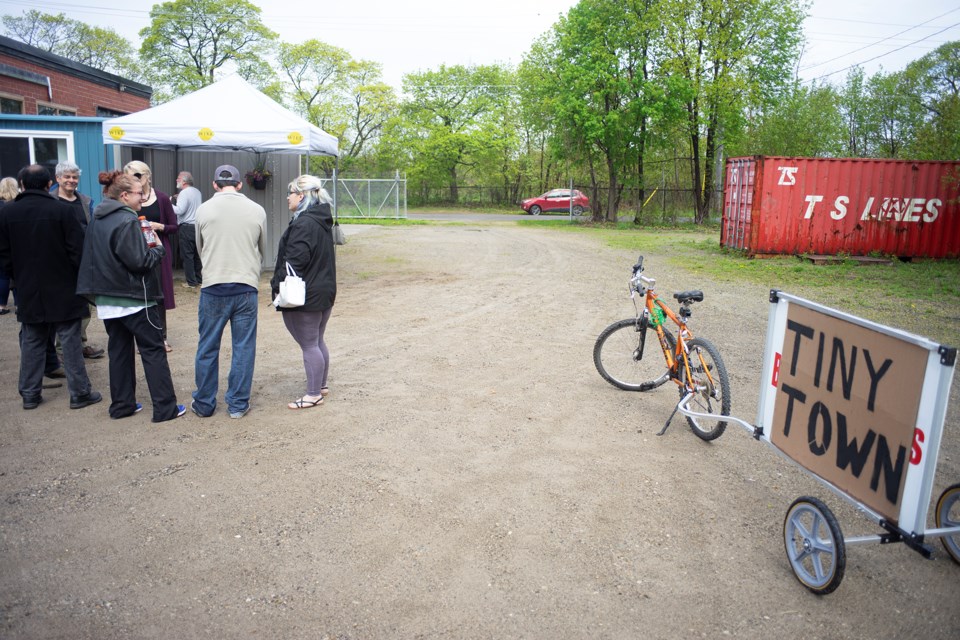Councillor Bob Bell had a broken shipping container and an idea — to create a tiny house as a proof-of-concept to address the city’s homelessness crisis.
On Thursday, Bell invited the public to tour the tiny home at Wike, his business on Stevenson Street South that manufactures bike trailers.
“As a city councilor, I am seeing a problem of crisis proportion — with the opioids stuff — there are people on the street everywhere. Our constituents want the problem solved. They don’t know how to solve it but they certainly don’t want people living and dying on the steets,” said Bell during the open house.
At his own cost, Bell retrofitted an 8’ by 20’ trailer with a bathroom, kitchen, window, living space and a door. He envisions 10 attached units together in what he calls a Tiny Town.
The tiny home is a proof of concept only and not intended to be lived in. Bell said he will not profit from the project in any way.
“It’s mostly my workmanship — I am not much of a craftsman so I wouldn’t be building anything else. It’s just to give people an idea of the space and how the tiny homes fit into the Tiny Town,” said Bell.
Bell estimates that 10 units can be built on a single foundation at a cost of about $500,000, or $50,000 each.
Over an expected 15-year lifespan, Bell said the tiny houses could be paid for through monthy Ontario Disability Support Program (ODSP) payments from the people who use them.
“Out of the ODSP income stream, you would have $200 going toward paying for the unit and $200 a month for maintenance and operation,” said Bell.
“The reason we haven’t built any affordable housing is because the units cost $150,00 or $200,000, that’s not sustainable,” he said.
Bell said there is a lot of homelessness in The Ward. Some people are ‘sleeping rough’ in tents on the IMICO site or in other wooded areas.
“Last year I was getting a rising number of requests from constituents to have the homeless moved,” said Bell. ““I was there before they were getting moved and while they were getting moved, because I wanted to experience what I was participating in. I didn’t really feel good, because I was moving someone who didn’t have a home.”
Bell decided to build the tiny home as an example of what can be accomplished. He said Wike has no plans to manufacture the homes and the open source building plans are being offered free to the public or to other municipalities looking to implement a similar project.
Fellow city councillor Mike Salisbury said the 155-square-foot home was roomier than he expected.
"I thought it was rather spacious, actually. I was not expecting it to be that big,” Salisbury
Tiny homes have been offered as a solution to homelessness in some other communities, what is different in Bell’s solution is a partnership with social services and the Wellington Guelph Drug Strategy, said MP Lloyd Longfield.
“This is an interim step we can provide for people who are not going to get into housing through the county — this could give them a place where they can get some treatment,” said Longfield. “It’s the treatment part of this development that we are most interested in from the federal government.”
Longfield said tiny houses could provide a bridge for people who are experiencing homelessness to receive treatement so they can be eligible for more permanent housing down the road.
“Sometimes when you try to get a person into housing when they are not well, it’s not going to work out for anybody,” said Longfield.
There are currently about 300 homeless people in Guelph on a waiting list for housing, said Adrienne Crowder, manager of the Wellington Guelph Drug Strategy.
She said the tiny houses could be a solution that fits the needs of the homeless in Guelph, while also meeting the needs of taxpayers.
“I would order 300 of these. I’m not sure everybody would want one of these, but I would ask who wants one if I had a magic wand,” said Crowder.
Guelph MPP Mike Schreiner hopes the lower-cost solution will be something the provincial government will get behind.
“They keep saying they are looking for efficient ways to deliver services. I think this is a relaly effective, cost-effective way to address the housing crisis we are facing,” said Schreiner. “Obviously this isn’t going to work for everyone, but I think for people who are sleeping in a tent or under the bridge by the river, this is a very viable option.”
Mayor Cam Guthrie said he likes the solution and the fact it is scalable.
“As a city we should just stop talking about these kinds of ideas and actually start implementing them. It’s something I think we should be embracing,” said Guthrie.
“It’s not only providing a roof over someone’s head, but also provinding the wrap-areound services for the people who would be living in them, it gives them a much better chance at success in their life than living in a tent in a park or a forest somewhere,” said Guthrie. “It also gives a sense of dignity to people too, and I think that’s something that shouldn’t be lost on this. It’s definitely better than sleeping rough.”
